A Frequency Signature RFID Chipless Tag for Wearable Applications
Abstract
:1. Introduction
2. Geometry and Numerical Results
2.1. Multi-Resonator Structure
2.2. TX and RX tag Antennas
2.3. Overall System Tag
3. Experimental Results
3.1. Stop-Band Microstrip Line
3.2. TX and RX Tag Antennas
3.3. 2-Bit Tag
4. Conclusions
Author Contributions
Funding
Conflicts of Interest
References
- Liu, N.; Lu, Y.; Qiu, S.; Li, P. Electromagnetic properties of electro-textiles for wearable antennas applications. Front. Electr. Electron. Eng. Chin. 2011, 6, 563–566. [Google Scholar] [CrossRef]
- Salvado, R.; Loss, C.; Gonçalves, R.; Pinho, P. Textile Materials for the Design of Wearable Antennas: A Survey. Sensors 2012, 12, 15841–15857. [Google Scholar] [CrossRef] [PubMed] [Green Version]
- Corchia, L.; Monti, G.; Tarricone, L. Rewiew on Wearable Antennas: Non-Textile Solutions vs. Fully-Textile Solutions. IEEE Antennas Propag. Mag. 2019, in press. [Google Scholar]
- Liu, Q.; Ford, K.L.; Langley, R.; Robinson, A.; Lacour, S. Stretchable Antennas. In Proceedings of the 6th European Conference on Antennas and Propagation, Prague, Czech Republic, 26–30 March 2012; pp. 10–13. [Google Scholar]
- Corchia, L.; Monti, G.; De Benedetto, E.; Tarricone, L. Wearable Antennas for Remote Health Care Monitoring Systems. Int. J. Antennas Propag. 2017, 2017, 3012341. [Google Scholar] [CrossRef]
- Corchia, L.; Monti, G.; Tarricone, L. Durability of Wearable Antennas Based on Nonwoven Conductive Fabrics: Experimental Study on Resistance to Washing and Ironing. Int. J. Antennas Propag. 2018, 2018, 2340293. [Google Scholar] [CrossRef]
- Kiourti, A.; Lee, C.; Volakis, J.L. Fabrication of Textile Antennas and Circuits With 0.1 mm Precision. IEEE Antennas Wirel. Propag. Lett. 2016, 15, 151–153. [Google Scholar] [CrossRef]
- Chahat, N.; Zhadobov, M.; Sauleau, R. Yagi-Uda textile antenna for on-body communications at 60 GHz. In Proceedings of the 7th European Conference on Antennas and Propagation, Gothenburg, Sweden, 8–12 April 2013; pp. 411–413. [Google Scholar]
- Monti, G.; Corchia, L.; Tarricone, L. Fabrication techniques for wearable antennas. In Proceedings of the 2013 European Radar Conference, Nuremberg, Germany, 9–11 October 2013. [Google Scholar]
- Monti, G.; Corchia, L.; Tarricone, L. Textile logo antennas. In Proceedings of the Mediterranean Microwave Symposium (MMS2014), Marrakech, Morocco, 12–14 December 2014; pp. 1–5. [Google Scholar]
- Scarpello, M.L.; Kazani, I.; Hertleer, C.; Rogier, H.; Vande Ginste, D. Stability and Efficiency of Screen-Printed Wearable and Washable Antennas. IEEE Antennas Wirel. Propag. Lett. 2012, 11, 838–841. [Google Scholar] [CrossRef]
- Kellomäki, T.; Virkki, J.; Merilampi, S.; Ukkonen, L. Towards Washable Wearable Antennas: A Comparison of Coating Materials for Screen-Printed Textile-Based UHF RFID Tags. Int. J. Antennas Propag. 2012, 2012, 476570. [Google Scholar] [CrossRef]
- Adami, S.E.; Zhu, D.; Li, Y.; Mellios, E.; Stark, B.H.; Beeby, S. A 2.45 GHz rectenna screen-printed on polycotton for on-body RF power transfer and harvesting. In Proceedings of the IEEE Wireless Power Transfer Conference (WPTC), Boulder, CO, USA, 13–15 May 2015; pp. 1–4. [Google Scholar]
- Whittow, W.G.; Chauraya, A.; Vardaxoglou, J.C.; Li, Y.; Torah, R.; Yang, K.; Beeby, S.; Tudor, J. Inkjet-Printed Microstrip Patch Antennas Realized on Textile for Wearable Applications. IEEE Antennas Wirel. Propag. Lett. 2014, 13, 71–74. [Google Scholar] [CrossRef] [Green Version]
- Li, Y.; Torah, R.; Beeby, S.; Tudor, J. Inkjet printed flexible antenna on textile for wearable applications. In Proceedings of the Textile Institute World Conference, Selangor, Malaysia, 15–17 May 2012. [Google Scholar]
- Genovesi, S.; Genovesi, S.; Costa, F.; Borgese, M.; Dicandia, A.F.; Manara, G.; Tedjini, S.; Perret, E. Enhanced chipless RFID tags for sensors design. In Proceedings of the IEEE International Symposium on Antennas and Propagation (APSURSI), Fajardo, Puerto Rico, 26 June–1 July 2016; pp. 1275–1276. [Google Scholar]
- Jang, H.; Lim, W.; Oh, K.; Moon, S.; Yu, J. Design of Low-Cost Chipless System Using Printable Chipless Tag with Electromagnetic Code. IEEE Microw. Wirel. Compon. Lett. 2010, 20, 640–642. [Google Scholar] [CrossRef]
- Genovesi, S.; Costa, F.; Borgese, M.; Dicandia, F.A.; Monorchio, A.; Manara, G. Chipless RFID sensor for rotation monitoring. In Proceedings of the IEEE International Conference on RFID Technology & Application (RFID-TA), Warsaw, Poland, 20–22 September 2017; pp. 233–236. [Google Scholar] [CrossRef]
- Preradovic, S.; Balbin, I.; Karmakar, N.C.; Swiegers, G.F. Multiresonator-Based Chipless RFID System for Low-Cost Item Tracking. IEEE Trans. Microw. Theory Tech. 2009, 57, 1411–1419. [Google Scholar] [CrossRef] [Green Version]
- Costa, F.; Genovesi, S.; Monorchio, A.; Manara, G. A Robust Differential-Amplitude Codification for Chipless RFID. IEEE Microw. Wirel. Compon. Lett. 2015, 25, 832–834. [Google Scholar] [CrossRef]
- Havlicek, J.; Svanda, M.; Polivka, M.; Machac, J.; Kracek, J. Chipless RFID Tag Based on Electrically Small Spiral Capacitively Loaded Dipole. IEEE Antennas Wirel. Propag. Lett. 2017, 16, 3051–3054. [Google Scholar] [CrossRef]
- Khaliel, M.; El-Awamry, A.; Fawky Megahed, A.; Kaiser, T. A Novel Design Approach for Co/Cross-Polarizing Chipless RFID Tags of High Coding Capacity. IEEE J. Radio Freq. Identif. 2017, 1, 135–143. [Google Scholar] [CrossRef]
- Vena, A.; Moradi, E.; Koski, K.; Babar, A.A.; Sydänheimo, L.; Ukkonen, L.; Tentzeris, M.M. Design and realization of stretchable sewn chipless RFID tags and sensors for wearable applications. In Proceedings of the IEEE International Conference on RFID (RFID), Penang, Malaysia, 30 April–2 May 2013; pp. 176–183. [Google Scholar]
- Andriamiharivolamena, T.; Vena, A.; Perret, E.; Lemaitre-Auger, P.; Tedjini, S. Chipless identification applied to human body. In Proceedings of the IEEE RFID Technology and Applications Conference (RFID-TA), Tampere, Finland, 8–9 September 2014; pp. 241–245. [Google Scholar]
- Preradovic, S.; Kamakar, N.; Amin, E.M. Chipless RFID tag with integrated resistive and capacitive sensors. In Proceedings of the Asia-Pacific Microwave Conference, Melbourne, Australia, 5–8 December 2011; pp. 1354–1357. [Google Scholar]
- Abbasi, Z.; Shariaty, P.; Hashisho, Z.; Daneshmand, M. SilicaGel-Integrated Chipless RF Tag for Humidity Sensing. In Proceedings of the 18th International Symposium on Antenna Technology and Applied Electromagnetics (ANTEM), Waterloo, ON, Canada, 19–22 August 2018; pp. 1–2. [Google Scholar]
- Salmerón, J.F.; Albrecht, A.; Kaffah, S.; Becherer, M.; Lugli, P.; Rivadeneyra, A. Wireless Chipless System for Humidity Sensing. Sensors 2018, 18, 2275. [Google Scholar] [CrossRef] [PubMed]
- El Matbouly, H.; Tedjini, S.; Zannas, K.; Duroc, Y. Chipless RFID Threshold Temperature Sensor Compliant with UHF and ISM Radio Frequency. In Proceedings of the 2nd URSI Atlantic Radio Science Meeting (AT-RASC), Meloneras, Spain, 28 May–1 June 2018; pp. 1–4. [Google Scholar]
- Genovesi, S.; Costa, F.; Monorchio, A.; Manara, G. Phase-only encoding for novel chipless RFID tag. In Proceedings of the IEEE RFID Technology and Applications Conference (RFID-TA), Tampere, Finland, 8–9 September 2014; pp. 68–71. [Google Scholar]
- Vena, A.; Perret, E.; Tedjini, S. A compact chipless RFID tag using polarization diversity for encoding and sensing. In Proceedings of the IEEE International Conference on RFID (RFID), Orlando, FL, USA, 3–5 April 2012; pp. 191–197. [Google Scholar]
- Li, J.; Djerafi, T.; Ren, F.; Wu, K. Chipless substrate integrated waveguide tag using time-domain reflectometry technique for millimeter-wave identification (MMID). In Proceedings of the 46th European Microwave Conference (EuMC), London, UK, 3–6 October 2016; pp. 45–48. [Google Scholar]
- Le, T.; Bahr, R.A.; Tentzeris, M.M.; Song, B.; Wong, C. A novel chipless RFID-based stretchable and wearable hand gesture sensor. In Proceedings of the European Microwave Conference (EuMC), Paris, France, 7–10 September 2015; pp. 371–374. [Google Scholar]
- Corchia, L.; Monti, G.; Tarricone, L. A Fully-Textile Chipless Tag. In Proceedings of the 48th European Microwave Conference (EuMC), Madrid, Spain, 23–27 September 2018; pp. 977–980. [Google Scholar]
- Jalil, M.E.; Samsuri, N.A.; Rahim, M.K.A.; Dewan, R. Compact chipless RFID metamaterial based structure using textile material. In Proceedings of the International Symposium on Antennas and Propagation (ISAP), Hobart, Australia, 9–12 November 2015; pp. 1–4. [Google Scholar]
- CST-Computer Simulation Technology. Available online: http://www.cst.com (accessed on 20 December 2018).
- Monti, G.; Corchia, L.; Tarricone, L.; Idda, T.; Coccetti, F.; Plana, R. Broadband compact planar monopole. Microw. Opt. Technol. Lett. 2011, 53, 2838–2842. [Google Scholar] [CrossRef]

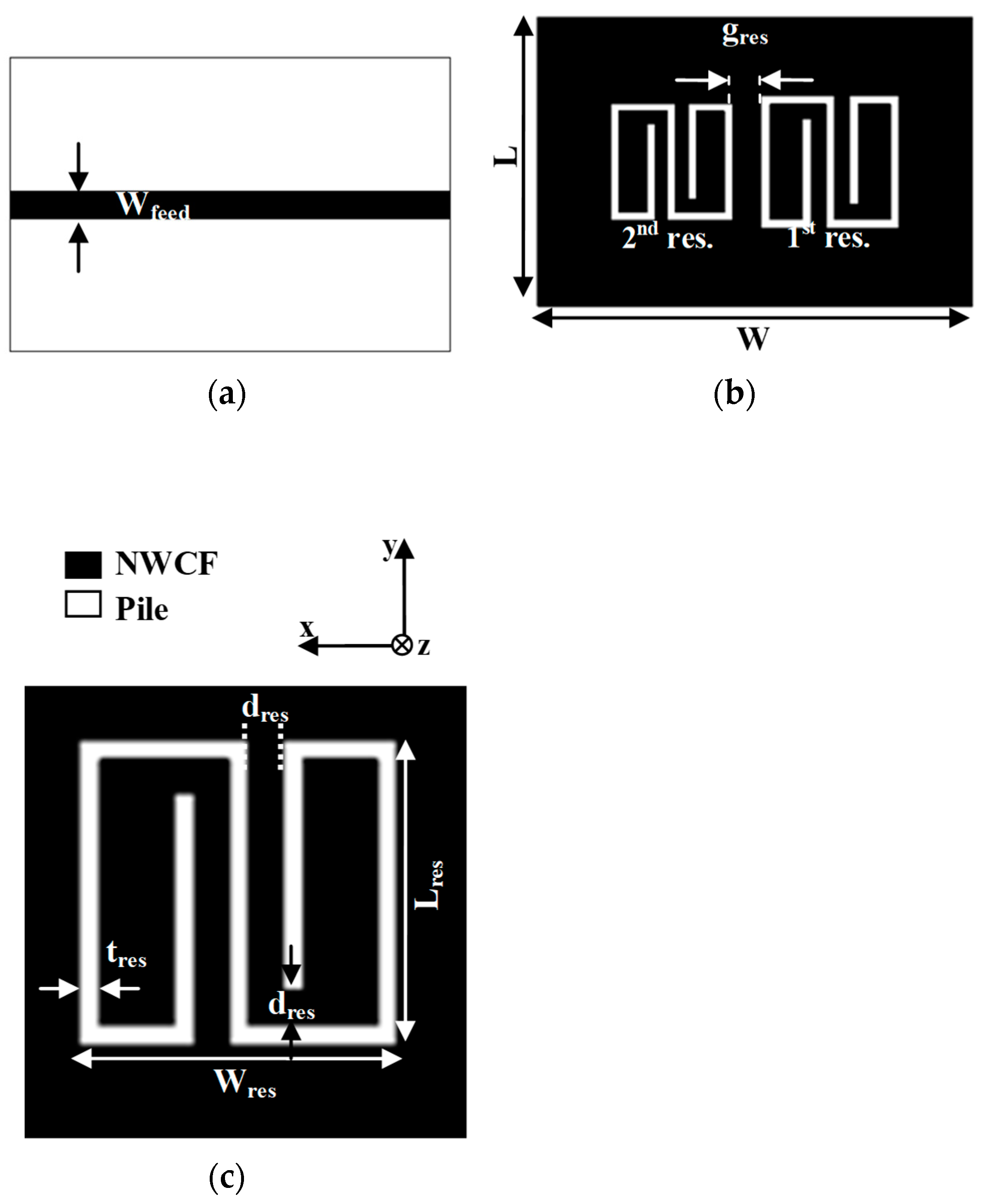

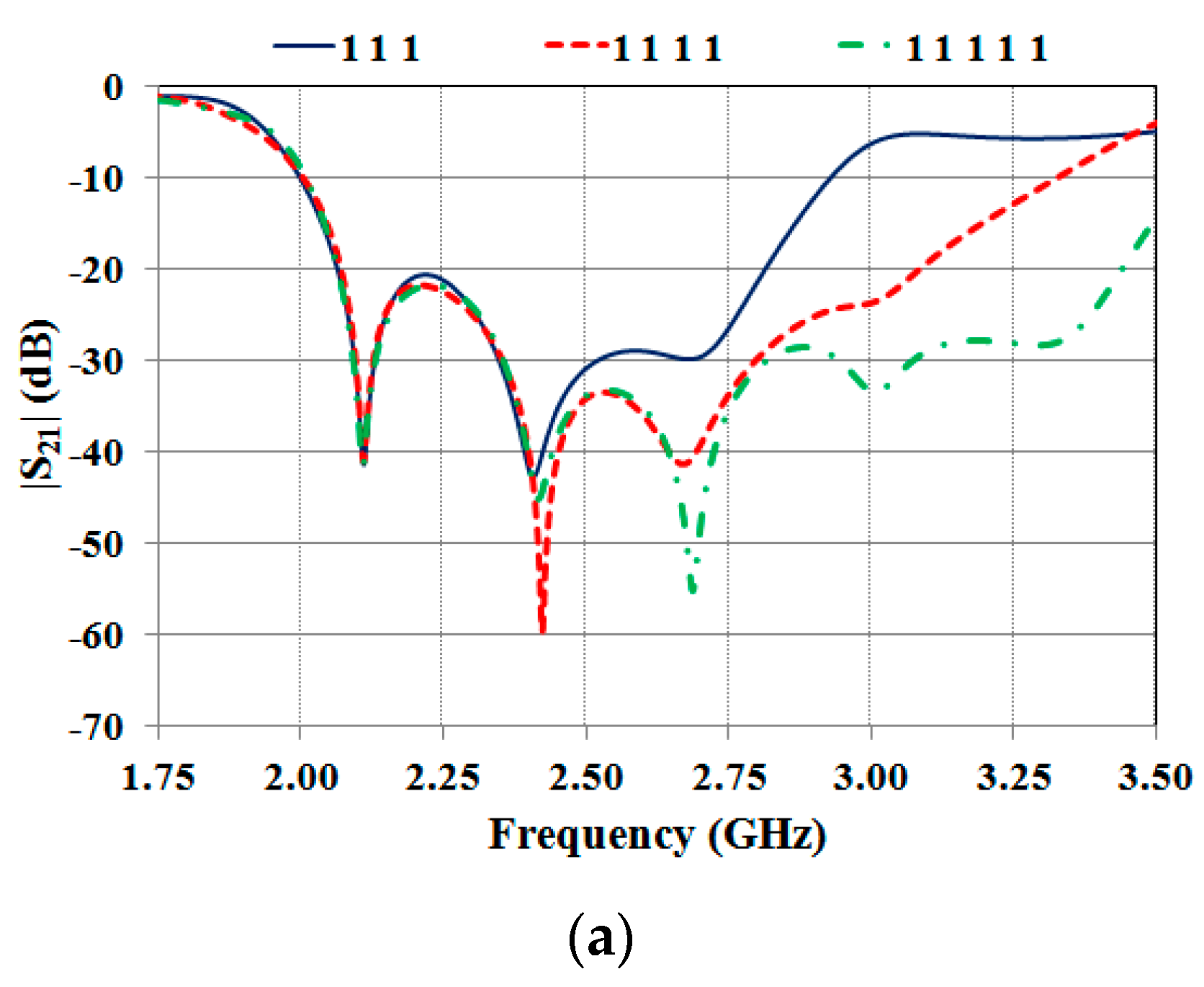
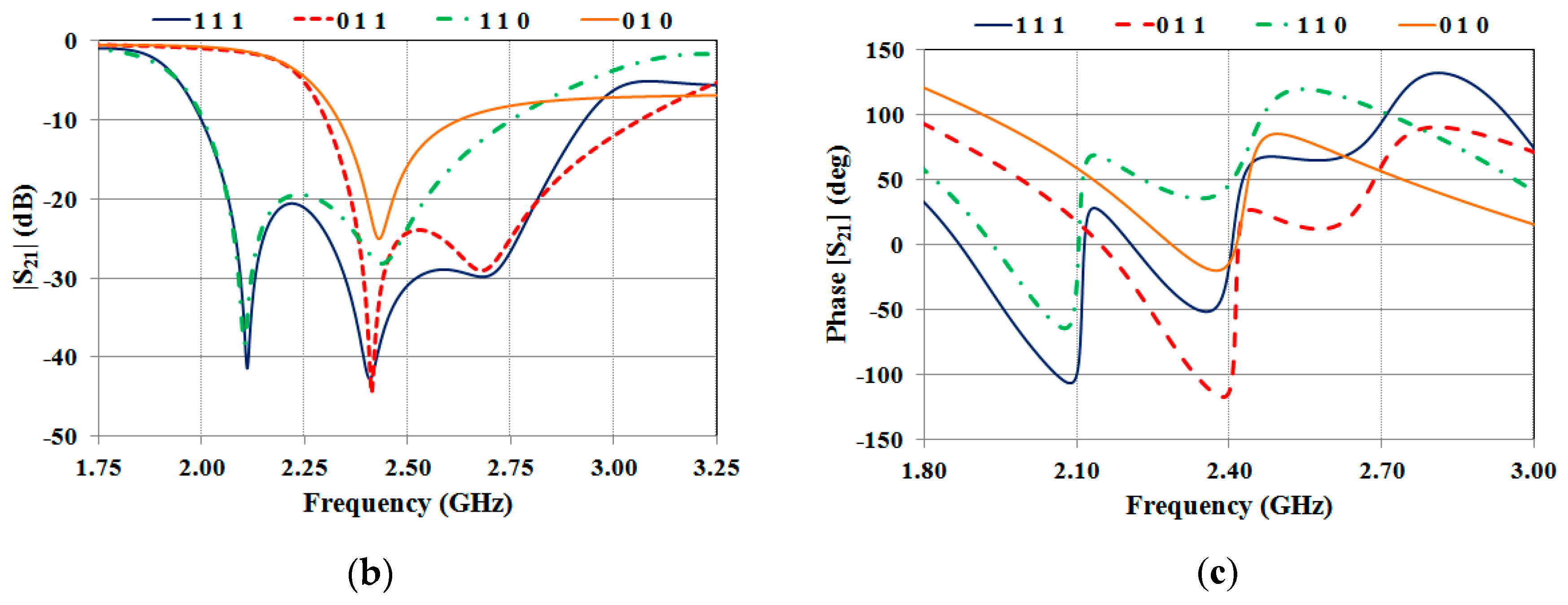
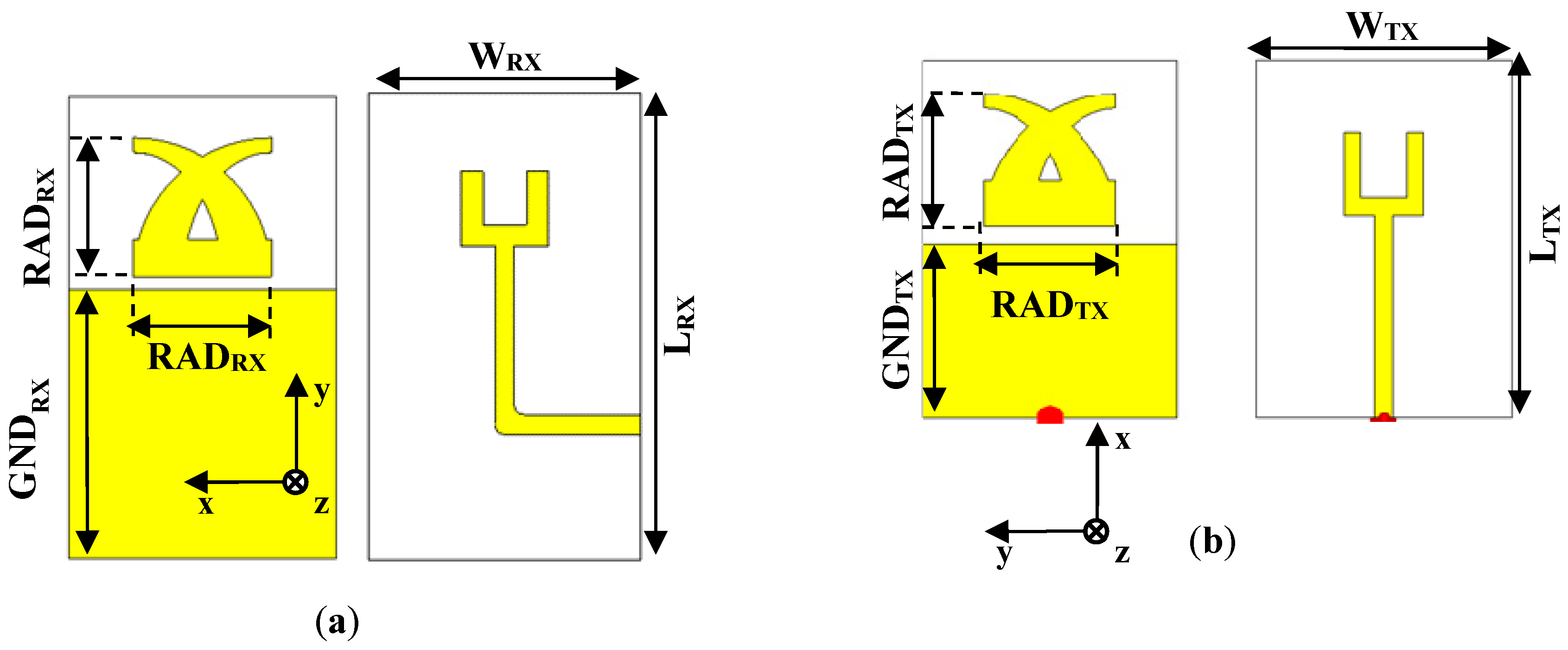


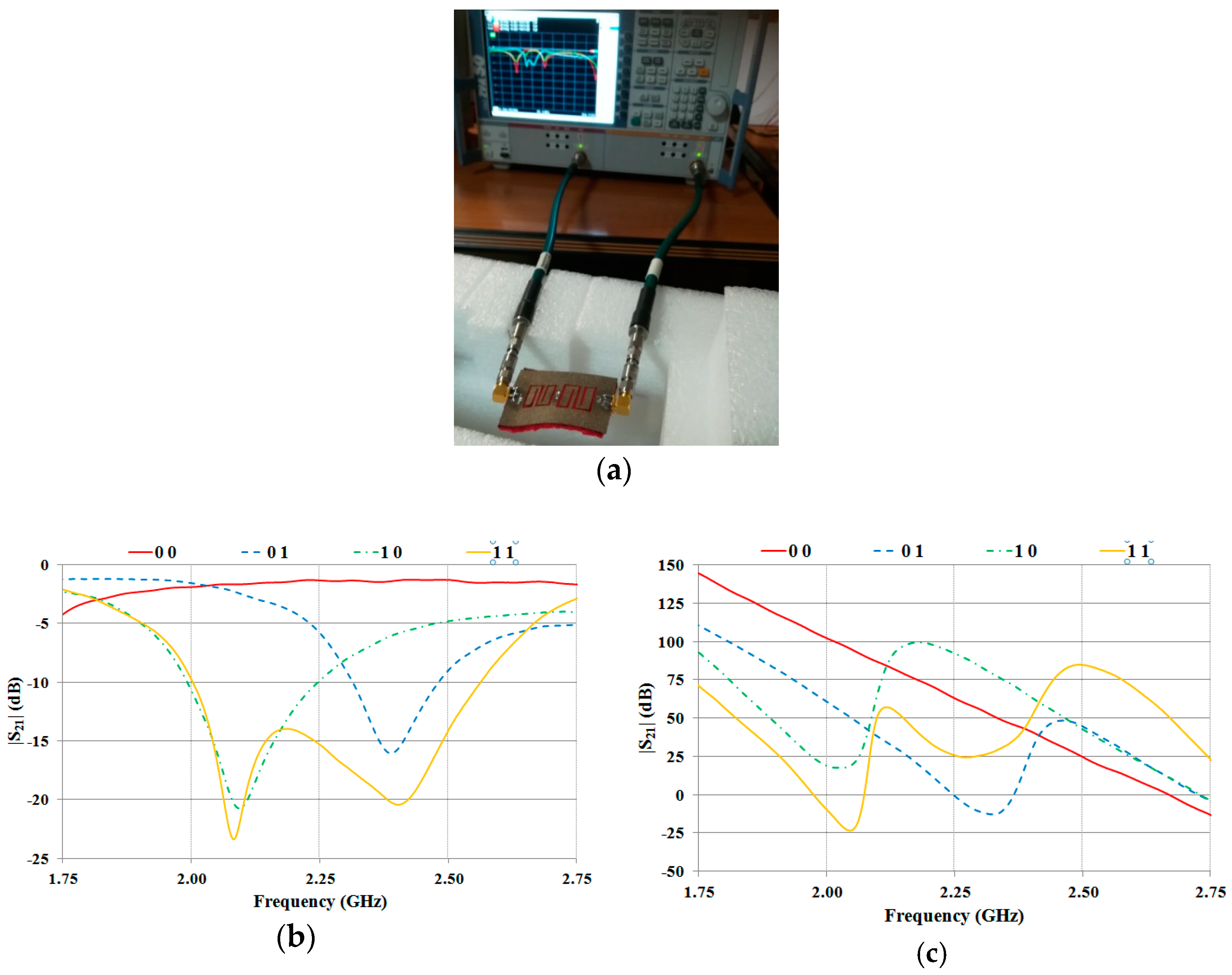
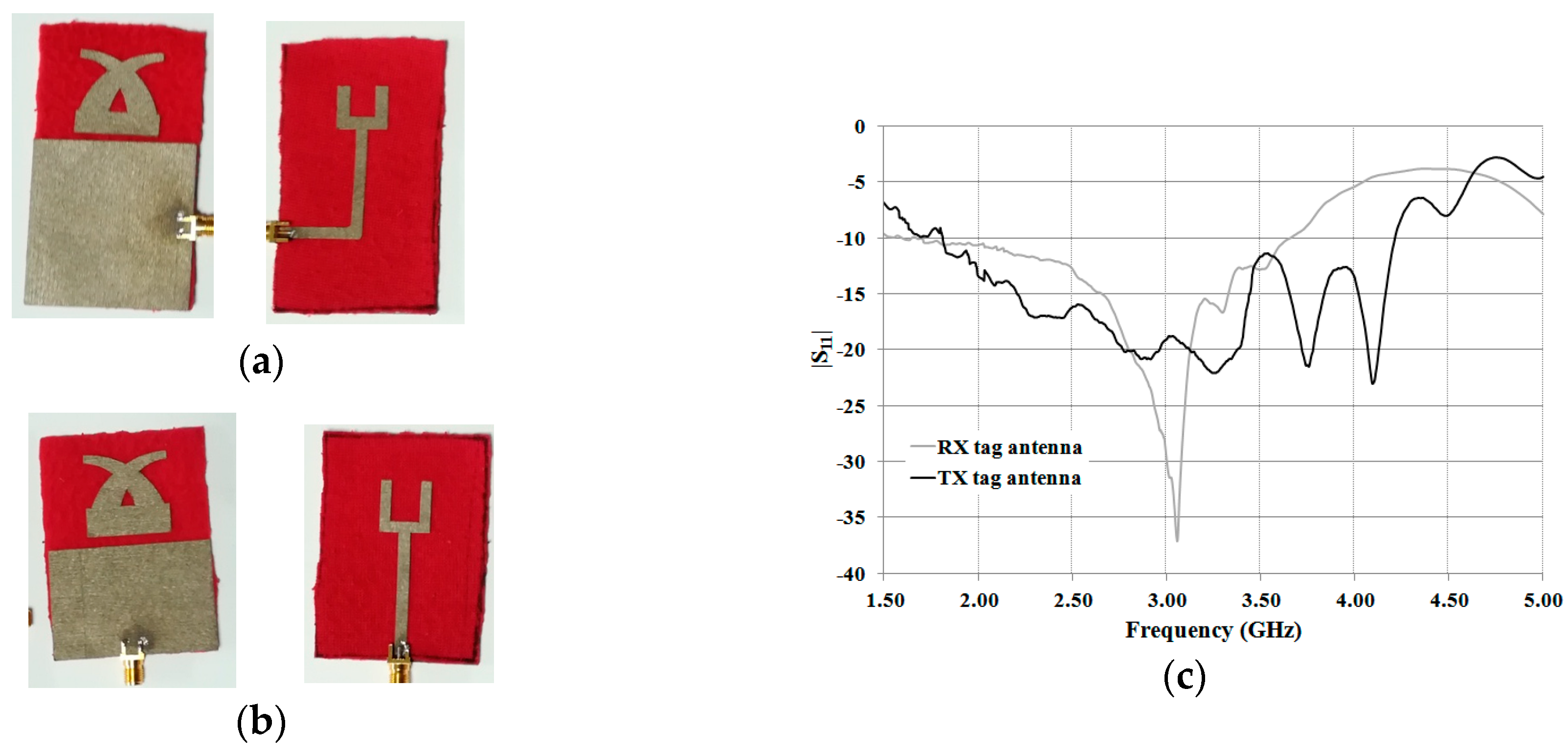
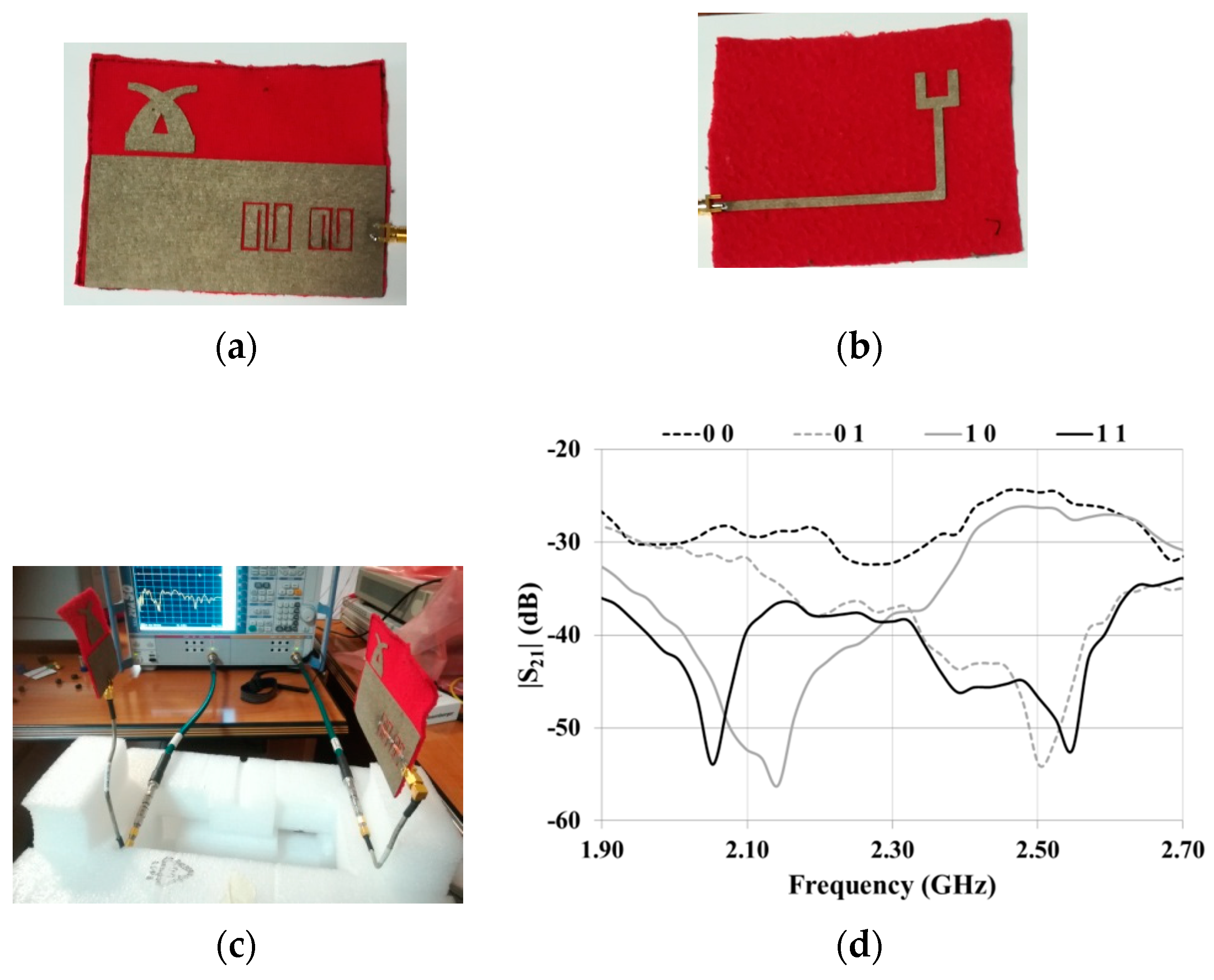
| RX antenna | TX antenna | ||||||
|---|---|---|---|---|---|---|---|
| WRX | LRX | GNDRX | RADRX | WTX | LTX | GNDTX | RADTX |
| 50 | 85.9 | 50 | 26 | 50 | 70 | 34.1 | 26 |
| BW-10 dB (GHz) | |S11| (dB) | Directivity (dBi) | |||||
|---|---|---|---|---|---|---|---|
| @ 2 GHz | @ 3 GHz | @ 4 GHz | @ 2 GHz | @ 3 GHz | @ 4 GHz | ||
| RX | 1.97–3.93 | –10.1 | –10.9 | –9.14 | 3.40 | 3.99 | 3.44 |
| TX | 1.86–4.2 | –13.3 | –11.03 | –17.9 | 2.75 | 4.06 | 4.17 |
| 2-bits Prototype | ||||||||
|---|---|---|---|---|---|---|---|---|
| W | L | Wfeed | Wres | Lres | tres | dres | gres | SF2 |
| 40 | 60 | 3.7 | 19.1 | 18.3 | 1.2 | 2 | 4 | 0.77 |
© 2019 by the authors. Licensee MDPI, Basel, Switzerland. This article is an open access article distributed under the terms and conditions of the Creative Commons Attribution (CC BY) license (http://creativecommons.org/licenses/by/4.0/).
Share and Cite
Corchia, L.; Monti, G.; Tarricone, L. A Frequency Signature RFID Chipless Tag for Wearable Applications. Sensors 2019, 19, 494. https://doi.org/10.3390/s19030494
Corchia L, Monti G, Tarricone L. A Frequency Signature RFID Chipless Tag for Wearable Applications. Sensors. 2019; 19(3):494. https://doi.org/10.3390/s19030494
Chicago/Turabian StyleCorchia, Laura, Giuseppina Monti, and Luciano Tarricone. 2019. "A Frequency Signature RFID Chipless Tag for Wearable Applications" Sensors 19, no. 3: 494. https://doi.org/10.3390/s19030494






